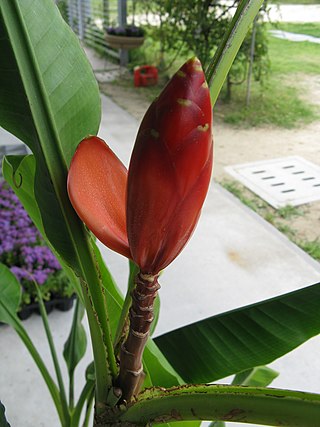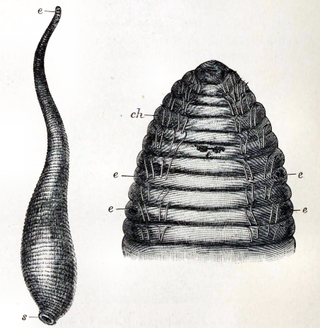
Hirudo medicinalis, or the European medicinal leech, is one of several species of leeches used as medicinal leeches.

Rhynchobdellida, the jawless leeches or freshwater leeches, are an order of aquatic leeches. Despite the common name "freshwater leeches", species are found in both sea and fresh water. They are defined by the presence of a protrusible proboscis instead of jaws, and having colourless blood. They move by "inchworming" and are found worldwide. The order contains 110 species, divided into 41 genera and three families. Members of the order range widely in length, usually between 7 and 40 mm. They are hermaphrodite. The order is not monophyletic.

Meristogenys is a genus of true frogs from Borneo. Its tadpoles are adapted to fast-flowing mountain streams and easily recognizable by their divided upper lip with ribs on the outside.

Haemadipsidae are a family of jawed leeches. They are a monophyletic group of hirudiniform proboscisless leeches. These leeches have five pairs of eyes, with the last two separated by two eyeless segments. The family is monotypic, containing only the subfamily Haemadipsinae, though as the family can apparently be divided into two or three distinct lineages, at least one of the proposed splits, while not a distinct family, might be a valid subfamily.

Pearson's horseshoe bat is a species of bat in the family Rhinolophidae. It is found in Bangladesh, Bhutan, China, India, Laos, Malaysia, Myanmar, Nepal, Thailand and Vietnam.

The least horseshoe bat is a species of bat in the family Rhinolophidae. It is found in Cambodia, China, India, Indonesia, Laos, Malaysia, Myanmar, Nepal, Thailand and Vietnam. It is a food source of the parasite Sinospelaeobdella, a jawed land leech.

The Chinese rufous horseshoe bat is a species of bat in the family Rhinolophidae. It is found in Bhutan, China, India, Nepal, and Vietnam.

Leeches are segmented parasitic or predatory worms that comprise the subclass Hirudinea within the phylum Annelida. They are closely related to the oligochaetes, which include the earthworm, and like them have soft, muscular segmented bodies that can lengthen and contract. Both groups are hermaphrodites and have a clitellum, but leeches typically differ from the oligochaetes in having suckers at both ends and ring markings that do not correspond with their internal segmentation. The body is muscular and relatively solid; the coelom, the spacious body cavity found in other annelids, is reduced to small channels.

A sucker in zoology is a specialised attachment organ of an animal. It acts as an adhesion device in parasitic worms, several flatworms, cephalopods, certain fishes, amphibians, and bats. It is a muscular structure for suction on a host or substrate. In parasitic annelids, flatworms and roundworms, suckers are the organs of attachment to the host tissues. In tapeworms and flukes, they are a parasitic adaptation for attachment on the internal tissues of the host, such as intestines and blood vessels. In roundworms and flatworms they serve as attachment between individuals particularly during mating. In annelids, a sucker can be both a functional mouth and a locomotory organ. The structure and number of suckers are often used as basic taxonomic diagnosis between different species, since they are unique in each species. In tapeworms there are two distinct classes of suckers, namely "bothridia" for true suckers, and "bothria" for false suckers. In digeneal flukes there are usually an oral sucker at the mouth and a ventral sucker posterior to the mouth. Roundworms have their sucker just in front of the anus; hence it is often called a pre-anal sucker.

Haemopis sanguisuga is a species of freshwater leech in the family Haemopidae. It is commonly called the horse-leech, but that is due to the similarity of its appearance to the leech Limnatis nilotica, which sometimes enters the nasal cavities of livestock. Haemopis sanguisuga does not behave in this way. Another synonym for this leech is Aulastomum gulo.

Musa beccarii is a species of wild banana, found in Malaysia, in Sabah. It is placed in section Callimusa.
Acetabulum in invertebrate zoology is a saucer-shaped organ of attachment in some annelid worms and flatworms. It is a specialised sucker for parasitic adaptation in trematodes by which the worms are able to attach on the host. In annelids, it is basically a locomotory organ for attaching to a substratum. The name also applies to the suction appendage on the arms of cephalopod molluscs such as squid, octopus, cuttlefish, Nautilus, etc.

Hirudo verbana is a species of leech.

Hirudo is a genus of leeches of the family Hirudinidae. It was described by Carl Linnaeus in his landmark 1758 10th edition of Systema Naturae.

Chisocheton cumingianus is a tree in the family Meliaceae. The tree is named for the English naturalist Hugh Cuming. Habitat is rain forests from sea-level to 1,300 metres (4,300 ft) elevation. C. cumingianus is found from India and tropical China through Indochina and throughout Malaysia. In the Philippines, the seeds of C. cumingianus are used to make a non-drying oil either for traditional medicine or as fuel for oil lamps.

The white sucker is a species of freshwater cypriniform fish inhabiting the upper Midwest and Northeast in North America, but it is also found as far south as Georgia and as far west as New Mexico. The fish is commonly known as a "sucker" due to its fleshy, papillose lips that suck up organic matter and aufwuchs from the bottom of rivers and streams.

Erpobdella octoculata is a freshwater leech in the Erpobdellidae family. This species can be found in Europe, the Mediterranean, and the Middle East.

Acanthobdella peledina is a species of leech-like clitellate in the order Acanthobdellida. It feeds on the skin and blood of freshwater fishes in the boreal regions of northern Europe, Asia and North America.

Pylaemenes sepilokensis is a species of stick insects (Phasmatodea) that is found in Borneo, more precisely in the Malay state of Sabah.
Tritetrabdella is a genus of terrestrial hemataphagous leeches in the family Haemadipsidae. Unlike other haemadipsid leeches, Tritetrabdella species have four annuli on their mid-body segments. They have three jaws, with a total 45 teeth, and lack salivary papillae. Tritrabdella feeds primarily on amphibians and probably on small mammals as well, but to a lesser extent. Bornean species may be endangered due to amphibian population decline, disturbance and fragmentation of habitat, and climate fluctuations.

















